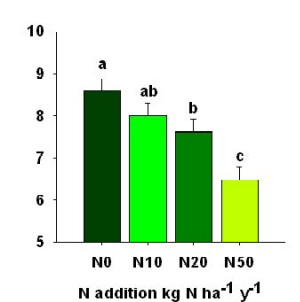Understanding how different drivers & their interactions affect the biodiversity and functioning of Scottish woodlands, moorlands and montane habitats.
Our long term and experimental research is directed mainly at terrestrial biotopes designated (Habitat and Biodiversity Action Plans) for their biodiversity importance: montane, heathland, native woodland (pine and birch), grassland and wetlands. See Integrated Research on Upland Ecosystems.
Atmospheric nitrogen deposition.
 Analyses to date have focused primarily on montane systems. We have found that increased N deposition reduces montane lichen biodiversity through increased growth of dominant higher plants. Analyses to date have focused primarily on montane systems. We have found that increased N deposition reduces montane lichen biodiversity through increased growth of dominant higher plants.
Britton, AJ; Fisher, JM 2007 Interactive effects of nitrogen deposition, fire and grazing on diversity and composition of low-alpine prostrate Calluna vulgaris heathland.. J appl ecol: 44, 125-135.
N deposition also interacts with other drivers, e.g. N impacts are enhanced by burning but constrained by temperature and grazing. Deposited N accumulates in plant tissue, causes a reduction in soil C:N and is rapidly leached into surface waters. Impacts on soil water are short-term, with rapid recovery, but soils become acidified, with potential long-term effects.
Nutrient pools in vegetation and soils, decomposition rates, hydrological linkages between communities and soil/surface-water chemistry have been characterised along a toposequence of Scottish montane habitats. The data are being used to develop models of nitrogen leaching.
See:
Contacts
Successional vegetation change
Experiments that manipulate heathland-woodland succession have demonstrated to date that even individual trees can substantially increase above - and below - ground biodiversity. see Impact of woodland invasion into moorland.
Ecosystem-level biodiversity responses to environmental change cannot generally be predicted from vegetation patterns alone (link WP3.3); e.g. soil mites appear to respond to different drivers than vegetation, which is being explored further. Browser-impact results show for the first time that, although browsing may cause a temporary decrease in C pools, birch saplings can compensate for such losses and are not C-limited in the longer-term. [Palacio, S; Hester, AJ; Maestro, M, et al 2008. Browsed Betula pubescens trees are not carbon-limited. Functional Ecology 22 (5), 808-815.
Contact
|